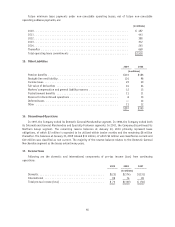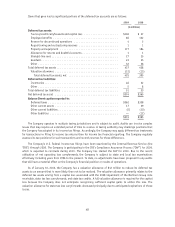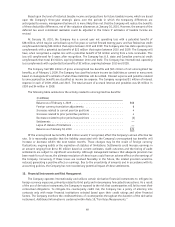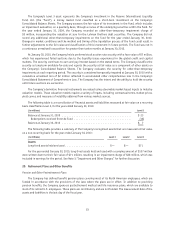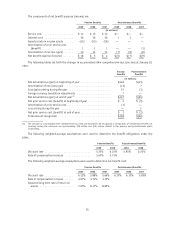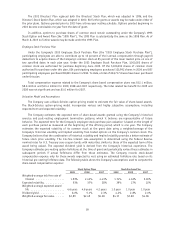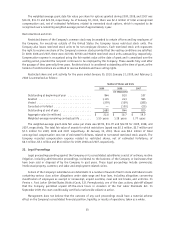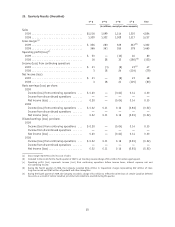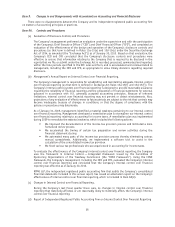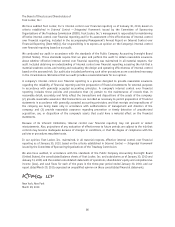Foot Locker 2009 Annual Report Download - page 74
Download and view the complete annual report
Please find page 74 of the 2009 Foot Locker annual report below. You can navigate through the pages in the report by either clicking on the pages listed below, or by using the keyword search tool below to find specific information within the annual report.Beginning with 2001, new retirees were charged the expected full cost of the medical plan and then-existing
retirees will incur 100 percent of the expected future increases in medical plan costs. Any changes in the health
care cost trend rates assumed would not affect the accumulated benefit obligation or net benefit income, since
retirees will incur 100 percent of such expected future increase. In addition, the Company maintains a
Supplemental Executive Retirement Plan (‘‘SERP’’), which is an unfunded plan that includes provisions for the
continuation of medical and dental insurance benefits to certain executive officers and certain other key
employees of the Company (‘‘SERP Medical Plan’’). The SERP Medical Plan’s accumulated projected benefit
obligation at January 30, 2010 was approximately $5 million. A one hundred basis point change in the health
care cost trend rates assumed would increase or decrease the accumulated projected benefit obligation by
approximately $1 million.
The expected long-term rate of return on invested plan assets is based on the plans’ weighted-average target
asset allocation, as well as historical and future expected performance of those assets. The target asset allocation
is selected to obtain an investment return that is sufficient to cover the expected benefit payments and to
reduce future contributions by the Company.
Plan Assets
During 2009, the Company changed the target composition of its U.S. plan assets from 65 percent equity and
35 percent fixed income securities to 50 percent equity and 50 percent fixed income. On January 29, 2010, the
Company contributed $60 million to the U.S. plan. This contribution was allocated to fixed income securities as
the Company migrated to its new target composition. The Company may alter the targets from time to time
depending on market conditions and the funding requirements of the pension plan. This change will reduce
future volatility with regard to the funded status of the plan. This change will, however, result in higher pension
expense due to the lower long-term rate of return associated with fixed income securities. Due to market
conditions and other factors, actual asset allocations may vary from the target allocation outlined above. The
Company believes that plan assets are invested in a prudent manner with an objective of providing a total return
that, over the long term, provides sufficient assets to fund benefit obligations, taking into account the Company’s
expected contributions and the level of risk deemed appropriate. The Company’s investment strategy seeks to
utilize asset classes with differing rates of return, volatility, and correlation in order to reduce risk by providing
diversification relative to equities. Diversification within asset classes is also utilized to ensure that there are no
significant concentrations of risk in plan assets and to reduce the effect that the return on any single investment
may have on the entire portfolio.
In late January 2008, the Company modified the actual asset allocation for its Canadian pension plan.
Effective with the beginning of 2008, the target allocation for the Canadian plan is 95 percent debt securities and
5 percent equity. The Company believes that plan assets are invested in a prudent manner with the same overall
objective and investment strategy as noted above for the U.S. pension plan. The bond portfolio is comprised of
government and corporate bonds chosen to match the duration of the pension plan’s benefit payment
obligations. This change will reduce future volatility with regard to the funded status of the plan. This change
has resulted in higher pension expense due to the lower long-term rate of return associated with fixed-income
securities.
Valuation of Investments
Significant portions of plan assets are invested in commingled trust funds. These funds are valued at the net
asset value of units held by the plan at year end. Stocks traded on U.S. security exchanges are valued at closing
market prices on the measurement date.
Investments in real estate are carried at their estimated fair value based on information supplied by
independent appraisers whereby each property is independently appraised and adjusted accordingly at least once
within a five-year period. The Company’s management reviews the fair value of each property during the
intervening years to determine whether an impairment has occurred since receiving the latest independent
appraisal and that no change is required to the fair value.
56


